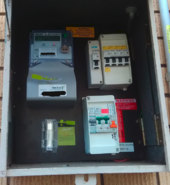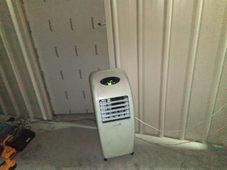monsterdeer
New Member
I have some solar and LiFePo4 questions. Situation: 4 100ah 12v lifepo4 low temp protection batteries in parallel. 4 100w solar panels in series plus another set of 4 100w solar panels in series and both sets are tied in parallel. Gives me about 80 volts and around 11 amps. MPPT 60 amp controller. Everything is fused/circuit breaker with bus bars to specs. Battery monitor with shunt. 2000w inverter. Batteries are stored in a battery box with between 2-4" foam plus reflective metallic sheeting. Battery box has a louvre to allow heat to escape in the summer. Dc relay hooked up with digital thermostat to shut off the solar panels from charging below 34 degrees. All parallel battery cables same size and length. All batteries were separately charged to full with a lithium battery charger before I hooked them all together. I used two high qlality voltmeters to make sure everything is copesthetic. QUESTIONS:
1. The solar panels in series/parallel connection produce 11amps. So why do I need a 60 amp controller? I can't see how 11amps input goes to 60 amp output. However, I can see how 80 volts gets reduced to around 12 to 13ish volts.
2. I bought a 20 amp lifepo4 battery charger to initially charge the batteries separately. So it does not produce anywhere near the .50c suggested charging rate for LiFePo4 batteries. Also, my MPPT only produces around 13.5 amps. So, how the heck do you have a way to charge at over 50 amps?
3. I bought 4 heated lifepo4 batteries from a "reliable" company. The first time it got real cold my two thermometers read 27 degrees but where supposed to be heated around 40 degrees. These 4 batteries were sent back. I am now paranoid of BMS heated batteries. So I bought 4 low temp protected batteries. Still paranoid, so I installed a 34 degree solar panel charging cut off relay. Now, it only cost $25, but I am thinking off putting another relay to disconnect the controller at 34 degrees. Is too much fail safe too much? In other words, are two relay cut offs bad?
4. My 2000 watt inverter has 3 110/120v outlets 15 amp outlets. So I ran 3 different 10 gauge wires to 3 15 amp 120v receptacles that have 2 usb ports each. I bought 3 inline 15 amp GFI protected cords one for each line. These GFIs cords are actually GFIs that connect to extension cords. Kind of iffy. Can you think of another way to put "proper" GFI protection in these "extension cords". Note, they don't sell 120v GFI receptacles with 2 USB ports. If they do, then they would be very very expensive.
5. My AC and microwave are wired directly to an in board generator that produces 120 volt. I once stupidly tried to run a 10 gauge 120 volt extension cord to an outlet to run my AC. Don't do this. Even if you had a soft start AC, the juice needed after the start will cause "damage". Believe me. It can be ugly. So I bought a 120 volt tower AC that uses 4 ice packs. Totally inconvenient. Any suggestions better than buying a portable tower AC?
6. I can not see anyway to hook up the 120 volt microwave to the system. Do I need to go through the converter or try to tie in before the generator. Each alternative sounds ugly.
1. The solar panels in series/parallel connection produce 11amps. So why do I need a 60 amp controller? I can't see how 11amps input goes to 60 amp output. However, I can see how 80 volts gets reduced to around 12 to 13ish volts.
2. I bought a 20 amp lifepo4 battery charger to initially charge the batteries separately. So it does not produce anywhere near the .50c suggested charging rate for LiFePo4 batteries. Also, my MPPT only produces around 13.5 amps. So, how the heck do you have a way to charge at over 50 amps?
3. I bought 4 heated lifepo4 batteries from a "reliable" company. The first time it got real cold my two thermometers read 27 degrees but where supposed to be heated around 40 degrees. These 4 batteries were sent back. I am now paranoid of BMS heated batteries. So I bought 4 low temp protected batteries. Still paranoid, so I installed a 34 degree solar panel charging cut off relay. Now, it only cost $25, but I am thinking off putting another relay to disconnect the controller at 34 degrees. Is too much fail safe too much? In other words, are two relay cut offs bad?
4. My 2000 watt inverter has 3 110/120v outlets 15 amp outlets. So I ran 3 different 10 gauge wires to 3 15 amp 120v receptacles that have 2 usb ports each. I bought 3 inline 15 amp GFI protected cords one for each line. These GFIs cords are actually GFIs that connect to extension cords. Kind of iffy. Can you think of another way to put "proper" GFI protection in these "extension cords". Note, they don't sell 120v GFI receptacles with 2 USB ports. If they do, then they would be very very expensive.
5. My AC and microwave are wired directly to an in board generator that produces 120 volt. I once stupidly tried to run a 10 gauge 120 volt extension cord to an outlet to run my AC. Don't do this. Even if you had a soft start AC, the juice needed after the start will cause "damage". Believe me. It can be ugly. So I bought a 120 volt tower AC that uses 4 ice packs. Totally inconvenient. Any suggestions better than buying a portable tower AC?
6. I can not see anyway to hook up the 120 volt microwave to the system. Do I need to go through the converter or try to tie in before the generator. Each alternative sounds ugly.





